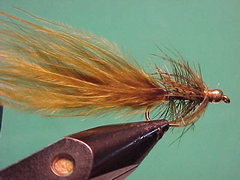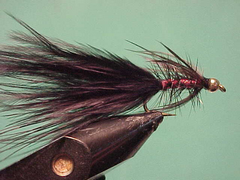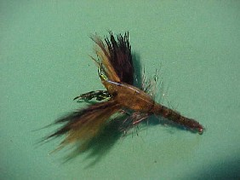Species
{{start}}
{{end}}
{{+1}}What trout eat – Central Tasmania{{-1}}
{{start}}
A general guide to what trout eat in Central Tasmania{{end}}

{{+1}}Shrek – original{{-1}}
{{start}}
This fly was out of left field as far as I am concerned and when first introduced to it had no great expectation of it finding its way into my fly box. I was wrong. The bright tinsel body certainly stands out and rather than spooking fish as I expected it seems to trigger a response from trout particularly in “smelt” water or slightly discolored or tannin water.{{end}}

{{+1}}Shrek- Chatto’s Fiona{{-1}}
{{start}}
A similar fly is also known as a "Bloody Mary" but I use the name 'Fiona' (Shrek's lady) as this fly is the same fly as the Shrek just different colored materials. Both are basically Woolly Buggers by design and just as the emerald green is a great option in the Shrek the red works well in combination with the black tail of the Fiona.{{end}}
{{+1}}What trout eat – Snowy Mountains of NSW and Victoria{{-1}}
{{start}}
This is a general guide to what the food sources for trout is in the harsh alpine snow regions of Nsw and Victoria.{{end}}
{{+1}}Fly fishing options – Snowy Mountains of NSW and Victoria{{-1}}
{{start}}
The snowed in high country of NSW and Victoria are amongst the harshest habits for trout in Australia. Some of the lake such as Guthega Pondage in NSW and Rocky Valley in Victoria even partially freeze over some years.{{end}}
{{+1}}What trout eat – Central Victoria{{-1}}
{{start}}
Food sources for trout are certainly more diverse and abundant in the more temperate regions of Victoria. That of course has to be balanced off against higher temperature water and of course the risk of drought.{{end}}
{{+1}}What trout eat – sub alpine NSW and Victoria{{-1}}
{{start}}
These are of course that band of rivers and lakes that are below the winter permanent normal snow line and generally between 700 meters and 1200 meters above sea level but still subject to the harshness of alpine climates.{{end}}
{{+1}}Fly fishing options – sub-alpine NSW and Victoria{{-1}}
{{start}}
These are of course that band of rivers and lakes that are below the winter permanent normal snow line and generally between 700 meters and 1200 meters above sea level but still subject to the harshness of alpine climates.{{end}}

{{+1}}Freshwater crustaceans{{-1}}
{{start}}
Yabbies, shrimp, snails, scud and daphnia are perhaps the most dominant of crustaceans that fresh water fish feed on.{{end}}
{{+1}}Playing & netting fish{{-1}}
{{start}}
It's one thing getting hits when fly fishing but its a completely different thing actually landing it. Playing and netting fish are two aspects of fly fishing that get less attention than they deserve. This post just glosses the surface but it may help.{{end}}













